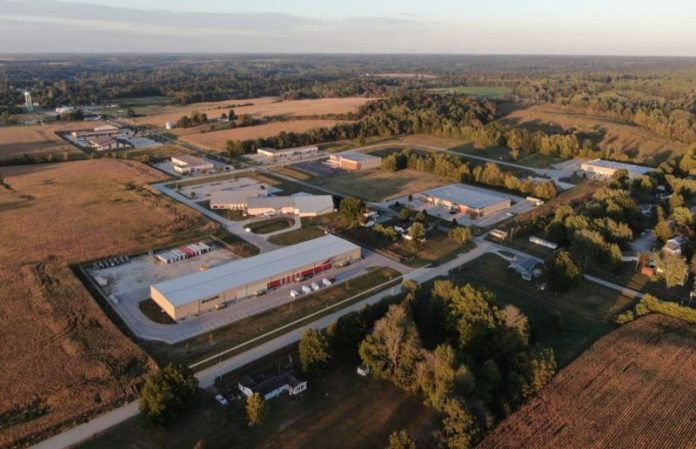Carol Johnson, Southern Indiana Business Report
ODON – Planning a shovel-ready project to attract economic development usually begins at the local level with government officials working together and then bringing in the state to market the site, but a new model that establishes a local/state partnership could change how some major projects are planned.
The change is meant to help Indiana compete for the nation’s biggest high-tech economic development opportunities.
LEAP, or Limitless Exploration/Advanced Pace, is a type of Innovation Development District that the Indiana Economic Development Corporation can establish in areas ripe for development.
The process for designating an IDD is outlined by Senate Enrolled Act 361, which passed in 2022. Among the requirements is that the IEDC collaborate with local governments and the local economic development representatives. An IDD can’t be established without approval from local officials.
The IEDC is currently leading the planning for a 9,000-acre LEAP district in Boone County that has the potential to draw $56 billion in investment. The Lebanon Research & Innovation District has already tapped a $3.7 billion investment by Eli Lilly. That investment will allow the IEDC to develop the next opportunity in Indiana while creating a return on investment to the state through the sale of property.
Last month, Inside Indiana Business reported that the IEDC is looking at other areas of the state that have potential to become LEAP districts, one of those is the WestGate Technology Park in Odon.
More revenue for investment
Bryant Niehoff is CEO of the Uplands Science and Technology Foundation and most recently was the executive director of Daviess County Economic Development Corporation. In both his current and former role, he has and does have an active role in the development of WestGate.

He said there are advantages – additional revenue stream from capturing additional sources of revenue– and drawbacks – making sure local interests are heard – to establishing a LEAP. An IDD captures incremental property, sales, and income tax off projects within that district so it brings additional sources of revenue to put into a project than the traditional tools available to local governments, such as tax increment financing or TIF.
“At its core, it’s bringing additional tools to the table as it pertains to local units of government being able to actively engage in economic development conversations, in particular as it relates to prospects,” Niehoff said. “Because it brings additional sources of revenue, because it captures additional incremental tax to put into a project, it’s adding more arrows to our quiver. From that angle, it’s a really powerful tool.”
However, this tool should be developed to balance both state and local economic and community development priorities.
“It’s incredibly important to approach these conversations from all angles, to discuss what about this makes sense for WestGate as a regional tech park and the counties that have invested so heavily into the technology park,” he added. “I think it’s vital to have an open dialogue with all players collaborating with the state and the IEDC on what is gained and what we are giving up. And from everything I’ve seen, they’re open to that.”
Leveraging the potential for growth at WestGate plays into the state’s strategy to turn Indiana into a microchip manufacturing and research hub.
The creation of the LEAP district has not gone unnoticed by those concerned about the loss of valuable farmland. Those concerns prompted Indiana Lt. Gov. Suzanne Crouch, who serves as Indiana Secretary of Agriculture, to issue a statement on the Boone County project.
“I’m hearing growing concerns from farmers and other constituents regarding the loss of farmland in the LEAP district in Boone County and in other parts of our state. Today, in addition to inventorying farmland lost from 2010 to 2022 (per HEA 1557), I’ve asked the Indiana Department of Agriculture to conduct an economic analysis of lost farmland to determine its value to local and state economies,” Crouch said.
“Let me be clear, I am not opposed to the LEAP district or others like it. I applaud the investment and jobs it will bring to our state. As the eighth largest farming state in the country, agriculture contributes more than $35 billion to our economy. State leaders must carefully consider the impact of lost agricultural production and, as Indiana’s Secretary of Agriculture and Rural Development, I will ensure this happens.”
WestGate poised for growth
WestGate One, the future microelectronics campus that will bring 550 jobs to the area, and NSWC Crane’s growing prominence as a driver of defense technology are both factors in WestGate being identified as a potential LEAP district.
In recent years, NSWC Crane has become a leader in the Pentagon’s modernization of the national defense, leading the development of new technologies that assist the warfighter and help protect the national interest. The WestGate tech park is expected to become the hub where many of the research and manufacturing companies will locate new labs and production facilities that will lead the production of these futuristic products.
“What NSWC Crane is doing on a defense tech space is phenomenal for the state of Indiana,” Niehoff said.
WestGate encompasses three counties – Daviess, Greene and Martin – as well as economic development groups such as Radius Indiana and Regional Opportunity Initiatives so any dialogue would include stakeholders from multiple entities.
The USTF is charged with implementing the master plan for the WestGate Tech Park and that includes providing the infrastructure to support expansion.
The counties where WestGate resides all have low tax rates, something that is good for property owners, but limits “the tool box” for local investment, Niehoff pointed out.
“We’re not capturing a lot in terms of local tools to put back into projects. An IDD expands that toolbox by capturing incremental income tax and sales tax,” he said. “We’re looking to expand WestGate in a major way and you have to have resources to do that.”



